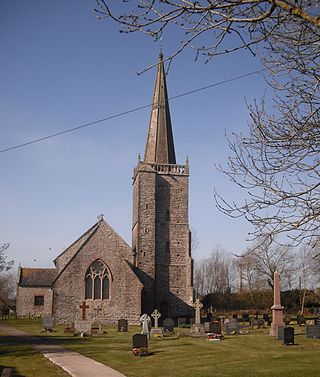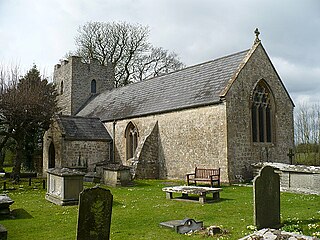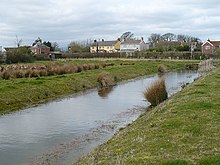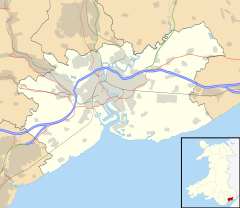
Rogiet is a small village and community in Monmouthshire, south east Wales, between Caldicot and Magor, 8 miles (13 km) west of Chepstow and 11 miles (18 km) east of Newport, which covers an area of 847 hectares (3.27 sq mi). It lies close to the M4 and M48 motorways, and the Second Severn Crossing. It has a railway station named Severn Tunnel Junction. Rogiet only has a population of 1,813 (2011).

Magor is a large village in Monmouthshire, south east Wales, about 9 miles (14 km) west of Chepstow and about 9 miles (14 km) east of Newport. It lies on the Caldicot Levels beside the Severn Estuary, and is in the community of Magor with Undy. Magor lies close to the M4 motorway.
Underwood is a settlement in the city of Newport, South East Wales. It is an early 1960s council housing estate that consists of houses, shops, a leisure centre, Baptist church and social club called "Iscoed Tavern" owned by the company red dragon pubs. There is a community centre which has a gym attached to it. The leisure centre is now up for sale.

Caldicot was an ancient hundred of Monmouthshire, Wales.

Whitson is a village on the outskirts of the city of Newport, South Wales. It is located about 7 miles (11 km) south east of Newport city centre on the Caldicot Levels, a large area of coastal land reclaimed from the sea. Administratively, Whitson is part of the community of Goldcliff.

Langstone is a community and village of the city of Newport, Wales. The area is governed by the Newport City Council. The community had a population of 3,279 in 2011.

Llanwern is a community in the eastern part of the City of Newport, South East Wales.
Newport Poor Law Union was a health and social security organisation in Newport, Monmouthshire and surrounding parishes. It was formed on 1 August 1836 under the Poor Law Amendment Act 1834 and was composed of 40 constituent parishes:

St. Bride's, St. Bride's Wentloog or St Brides Wentlooge is a hamlet to the south west of the city of Newport in South Wales.

Redwick is a small village and community (parish) to the south east of the city of Newport, in Wales, United Kingdom. It lies within the Newport city boundaries, in the historic county of Monmouthshire and the preserved county of Gwent. In 2011 the population was 206.

The Caldicot and Wentloog Levels are two areas of low-lying estuarine alluvial wetland and intertidal mudflats adjoining the north bank of the Severn Estuary, either side of the River Usk estuary near Newport in south east Wales. They are also known collectively as the Monmouthshire Levels or Gwent Levels, and the name Wentloog is sometimes spelled Wentlooge in official publications.
Magor and St Mellons Rural District was created on 1 April 1935 from Magor Rural District and St Mellons Rural District in the administrative county of Monmouthshire. The district was a mixture of suburban and semi-rural parishes around Newport and had its headquarters in Baneswell, Newport.

Newport Wetlands is a wildlife reserve covering parts of Uskmouth, Nash and Goldcliff, in the south-east of the city of Newport, South Wales.

Nash is a village and community to the south of the city of Newport, South Wales, in the Lliswerry ward.
Gwent Wildlife Trust (GWT) is a wildlife trust covering the area between the lower Wye and Rhymney rivers which forms the vice county of Monmouthshire in south-east Wales. It is a registered charity and a member of the Wildlife Trusts Partnership.

Goldcliff Priory was a Benedictine monastery in Goldcliff, Newport, South Wales. It was established in 1113 by Robert de Chandos as a subsidiary house of the Abbey of Bec in Normandy. The priory was built on a coastal site, now the land of Hill Farm. In the 1950s, the Monmouthshire writer Hando noted the outlines of buildings visible as grass patterns or crop marks, but by the 1970s the only remaining structural element was part of a cellar in the farm house.

The Church of St Mary the Virgin, Nash is the parish church of the village of Nash, situated about 2 miles (3.2 km) south of the city of Newport, Wales. Described as "the cathedral of the moors" by Monmouthshire historian Fred Hando, the large church is medieval in origin, with additions and restorations dating from the 18th and 19th centuries. Newman describes the 15th-century steeple as "unique in South East Wales". Since 3 January 1963 it has been designated a Grade I listed building primarily due to its "medieval tower with fine spire."

Pîl is a Welsh placename element. The name is defined as the tidal reach of a waterway, suitable as a harbour, and is common along the Bristol Channel and Severn Estuary. The highly localised distribution suggests it may have been part of a common maritime culture on the waterways within the tidal reach of the Severn Sea.

St Mary Magdalene's Church stands in the village of Goldcliff, to the southeast of the city of Newport, Wales. An active parish church and a Grade II listed building, it is situated directly behind the Farmer's Arms public house.























